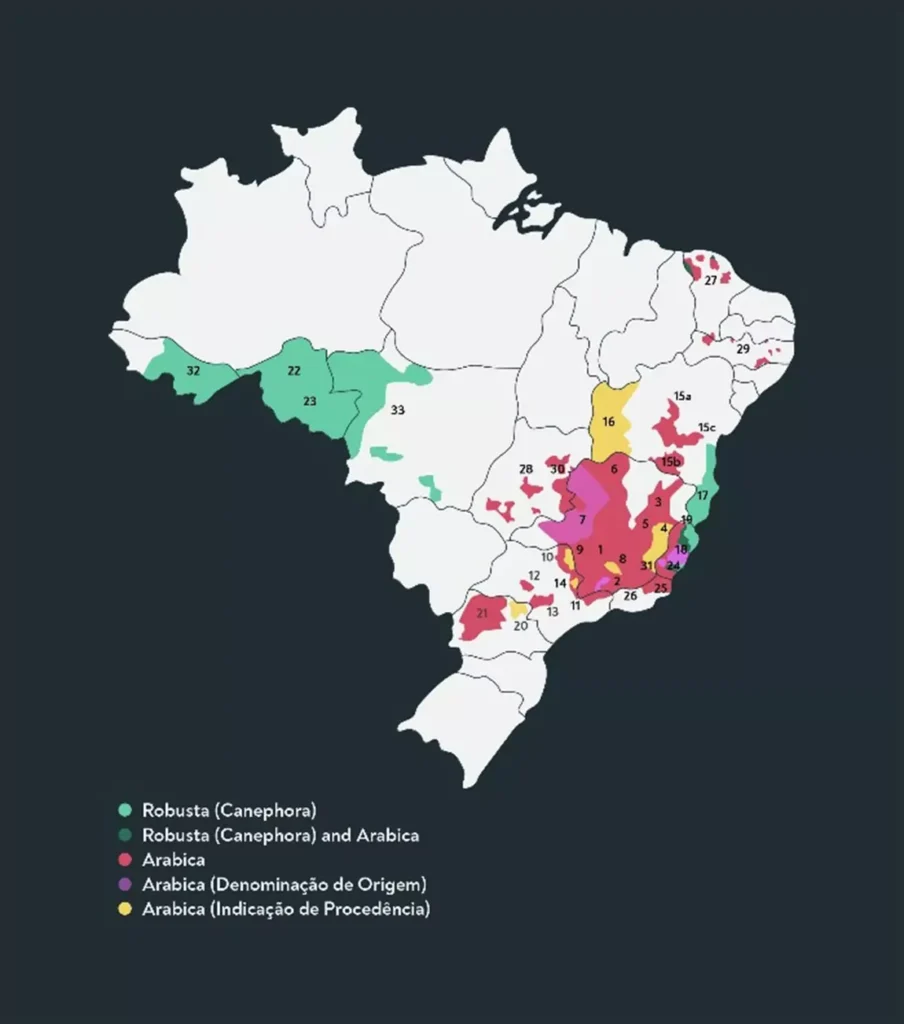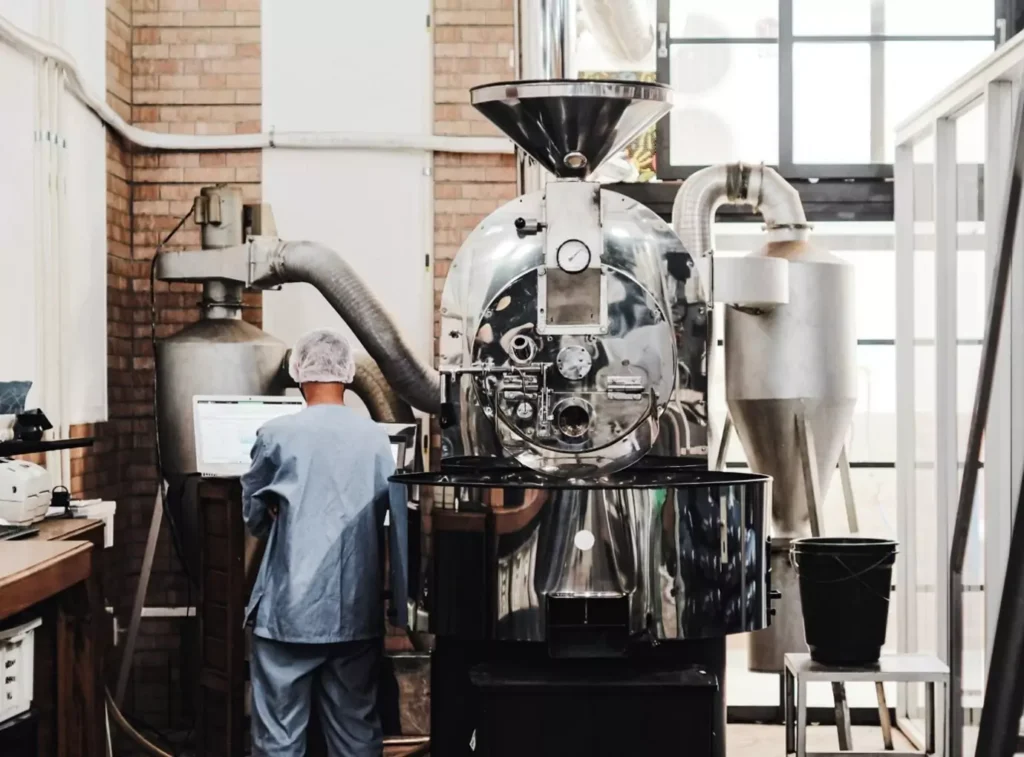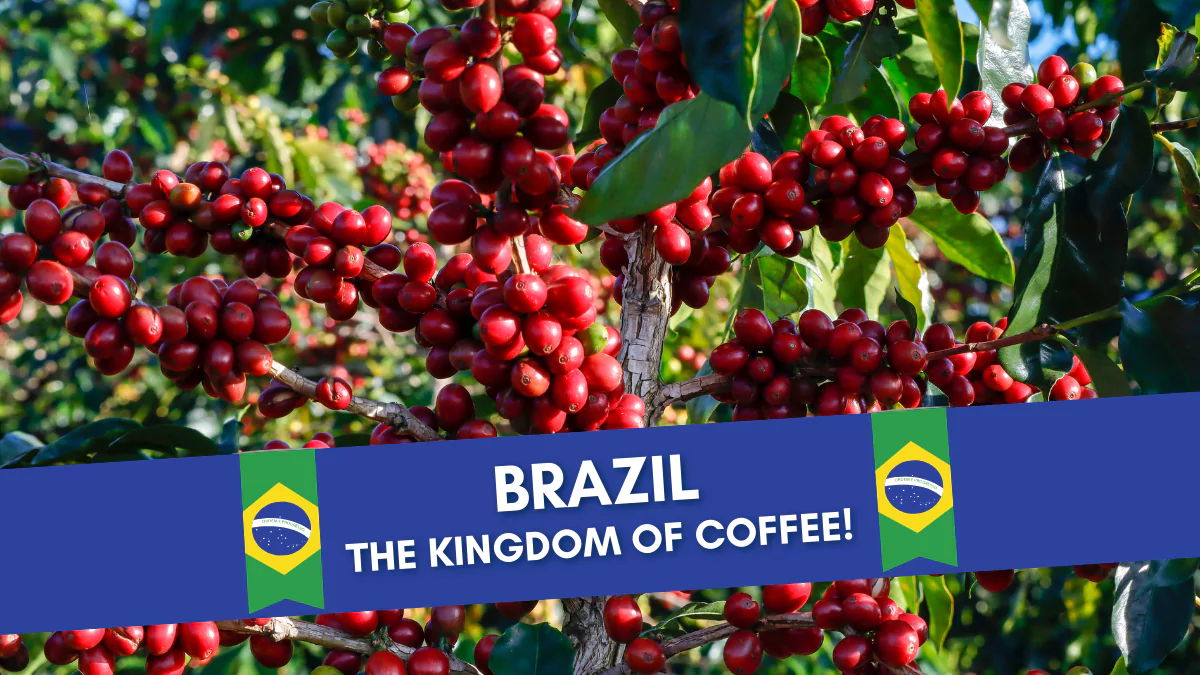Brazil is the world’s largest coffee-growing country, which is no accident. The history of coffee cultivation dates back to the 18th century, when the plant was first introduced to the country. Coffee soon became one of the most important economic sectors, and Brazil’s coffee plantations became famous around the world.

The Kingdom of Coffee!
Coffee is grown in half of Brazil’s 26 states. Most of the country’s coffee is grown in the 5 southeastern regions.
Bahia: one of the newest coffee-growing regions that has gained a reputation in recent decades for quality Arabica coffee, often with complex, fruity and floral notes
Espírito Sano: this region is more famous for growing robusta coffee, which offers stronger, more bitter flavor profiles and is often used in blends
Minas Gerais: the largest coffee-growing region, famous for its high-quality Arabica coffees. The region is known for its rich, chocolatey and nutty flavors, especially in the Cerrado and Sul de Manas areas.
Sao Paulo: the Mogiana region, known for its smooth, balanced coffees, often with sweet, fruity and floral notes
Parana: coffee beans are known for their unique flavor profile. The Arabica coffee produced here has sweet, fruity notes and an excellent balance between acidity and body.

These regions differ not only in their climate and terroir, but also in the typical cultivated species and varieties, the production system, the use of technology and mechanization, and the economics and ownership structure of a typical farm.
Let’s get to know the main types of coffee grown in Brazil and their characteristics

Arabica Coffee
This is the most popular and widespread type of coffee in Brazil. It accounts for 70-80% of the country’s coffee production.
1) Bourbon:
- characteristics: sweet, fruity flavors, medium acidity, smooth body
- Growing region: Minas Gerais, Sao Paulo
- interesting fact: an old breed that was brought to Brazil in the 1800s
2) Mundo Novo:
- characteristics: rich, balanced flavors, medium acidity, greater body
- Growing region: Minas Gerais, Bahia, Paraná
- interesting fact: Mundo Novo is a cross between the cultivation of Buorbon and Typica
- 3) Catuai:
- characteristics: balanced flavors, medium acidity, strong body
- growing region: Minas Gerais, Sao Paulo, Paraná
- Interesting fact: a hybrid breed created by crossing Mundo Novo and Catturra
- 4) Yellow Bourbon:
- characteristics: sweet, fruity notes, medium acidity
- growing region: Minas Gerais, Sao Paulo
- interesting fact: a rare version of Bourbon with yellow fruit, which is famous for its special flavor profile

Robusta Coffee (Coffea canephora)
Robusta coffee is grown in smaller quantities than Arabica. This variety accounts for 2-30% of coffee production
1) Conilon
- characteristics: strong, bitter taste, low acidity, large body
- growing region: Espirito Santo, Rondonia
- interesting fact: a special Robusta variety that is often used for instant coffee and blends
Special types of coffee can also be found in Brazil, such as
1) SL28
- characteristics: high acidity, fruity and floral notes, complex flavor profile
- growing region: experimental plantations mainly in Minas Gerais
- interesting fact: it originally comes from Kenya and is increasingly popular on the specialty coffee market
2) Icatu
- characteristics: medium acidity, sweet, chocolate notes
- growing region: Minas Gerais, Bahia
- interesting fact: it was created by crossing arabica and robusta to make it more resistant to diseases
Once we have delved into the main varieties grown in the country and learned the difference between cinolone and robusta, let’s learn about the special coffee growing methods that affect the flavor profile and quality of the coffee.

In Brazil, coffee is grown using a mixture of modern technologies and traditional methods. Most plantations are spread over large areas where mechanized picking is used, especially for Robusta coffee. Arabica coffee is hand-picked to ensure the best quality
Coffee processing methods: shapers of taste and quality
Coffee processing methods have a significant impact on the final flavor profile and quality. during processing, the pulp is removed from the coffee cherry to get to the coffee beans. different methods result in different flavors and body. Let’s see the most important coffee processing methods.

Dry processing: freshly picked coffee cherries are spread out in the sun, usually on large drying beds or concrete floors, and the cherries are rotated regularly to avoid mold. Drying can take several weeks. The dried husks are removed by machines to access the coffee beans.
Washed processing: freshly picked cherries are soaked in water so that the pulp can be separated more easily. The beans are fermented to break down the mucilage layer. The beans are dried on drying beds or in machines until they reach the right moisture content.
Semi-washed processing: the cherries are peeled to remove the outer skin, but leave the mucilage layer. After drying, the slimy layer is removed
Giling Basah: cherries are peeled and fermented, then briefly dried. the mucilaginous layer is removed from the beans after drying and they are dried again until the final moisture content is reached
Coffee processing methods have a significant impact on the final taste and quality of coffee. Cultivation regions and local customs influence which method farmers choose. Dry processing results in rich, full-bodied flavors, while washed processing provides clean, acidic flavor profiles. The semi-washed method is sweet and balanced, while the Giling Basah method gives the coffee a unique earthy taste.

In the rest of the blog, we are looking for answers to how to find the best Brazilian coffee, how to approach roasting and coffee brewing to get the best flavors.
Hugo Wolff, founder of Wolff Café, one of Brazil’s finest specialty coffee roasters, introducAAes you to the art of coffee roasting.
Hugo Wolff began his coffee career as a producer, after serving in the Brazilian Navy for a decade, he set up a coffee farm. From the very first harvest, he made special quality coffee and created the on-site roaster, then moved the roasting plant to Sao Paulo, becoming one of the best-known roasters in Brazil.

Currently, most of the best Brazilian coffees come from a limited number of regions, says Hugo. To get the best results from Brazilian coffee, you have to let go of your expectations as both a roaster and a barista, and don’t expect all Brazilian coffee to behave the same way.
Light roasting: the beans are light brown, natural acids and original flavors dominate
Medium roast: medium color, balanced flavor profile, this is the most widely used roasting method, the most ideal for espresso
Dark roast: dark brown, black color, oily surface, used for espresso blends to achieve a rich, full-bodied taste.
Roasting methods contribute greatly to the flavor profile and quality of the final cup of coffee. Brazil’s roasting culture is rich and diverse, allowing coffee lovers to discover a variety of flavors and aromas.
There are several factors to consider when comparing Brazilian and Colombian coffee, as both countries are among the world’s largest coffee producers, but grow coffee in different climates and geographical conditions.
Brazilian Arabica coffee:
- usually milder, less acidic,
- with chocolate, hazelnut and caramel flavors
- full-bodied and sweeter coffees, with smooth, balanced flavors
Colombian Arabica coffee:
- more lively acidity, complex taste
- citrus, berry fruits, floral notes
- medium body, often with vinous flavors
Both types of coffee are of high quality, and it is worth experimenting with both to find the coffee that best suits your taste
Arabica coffee specialties that should not be missed:
The Arabica coffee variety offers many coffees with special and flavor profiles in the world. Some of these offer a truly memorable and outstanding experience that every coffee lover should try. Let’s see which Arabica coffee specialties are not to be missed:
Brazilian Daterra: The popular coffee of the Corrado region with chocolate, hazelnut and honey notes
Brazilian Yellow Bourbon: fruity sweet, slightly spicy notes, one of Brazil’s iconic Arabica varieties,
Brazilian santos: soft, sweet with slightly chocolatey, caramel notes, the most common type of Arabica coffee, which is made special by its high quality and delicious taste.
Brazilian Peaberry: full-bodied, sweet, caramel, fruity notes. Peaberry coffee beans are rare, as the cherry develops from a single coffee bean, giving it a more concentrated and rich taste.
Discover the world of Brazilian coffee and enjoy the unique taste experiences that these high-quality beans offer. Making the best Brazilian espresso means truly understanding the work that goes into producing the coffee and how the terroir and techniques of the producers make the coffee unique.



